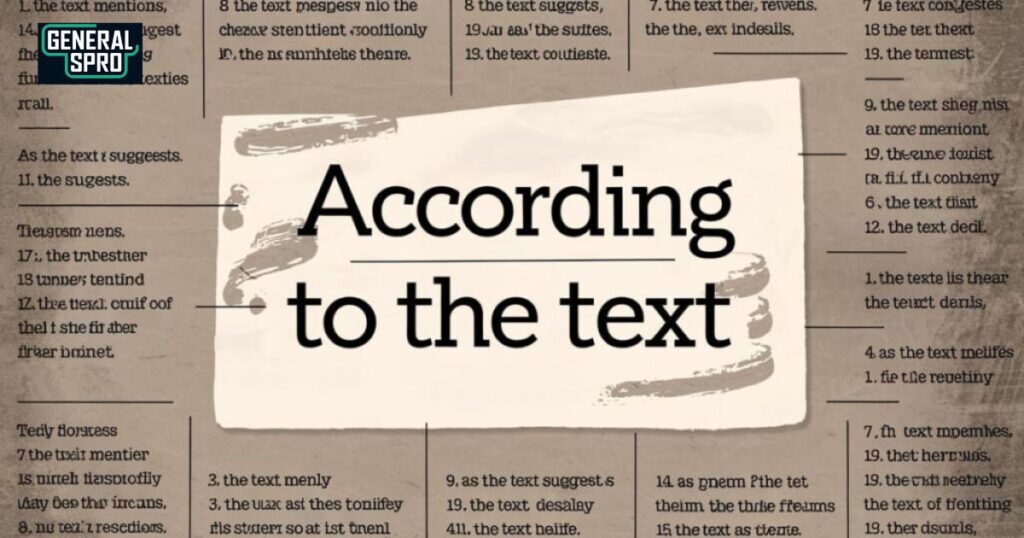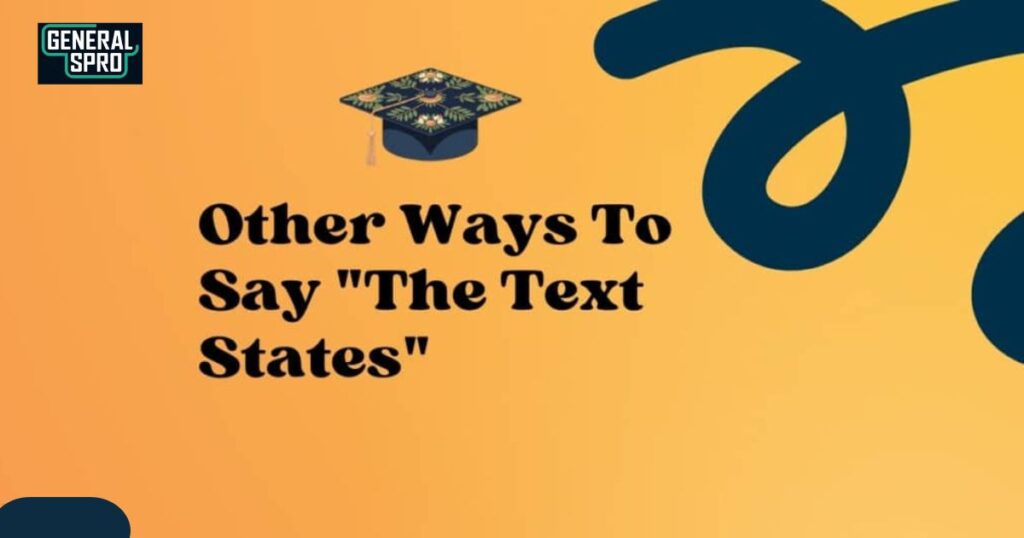Writing compelling academic content demands sophistication in how we reference source materials. Moving beyond the basic “the text states” opens doors to more nuanced and professional communication.
This guide explores creative alternatives that transform your writing from mundane to masterful.
Is It Professionally Good to Use “The Text States”?

Relying heavily on “the text states” can undermine credibility in academic writing. Think of your writing as a symphony—using the same note repeatedly creates monotony, while varying your expressions adds depth and demonstrates mastery of language.
Professional communication demands diverse ways of introducing textual evidence while maintaining clarity and precision.
Modern academic standards favor sophisticated citation methods that convey specific relationships between ideas.
For instance, when a source makes a bold claim, “the text argues” carries more weight than the neutral, “the text states.” Similarly, “the passage reveals” suggests discovering hidden meaning, perfect for literary analysis.
Comprehensive List of Alternatives to “The Text States”
Let’s explore powerful alternatives that elevate your writing from basic to brilliant. Each option serves a unique purpose in formal variations of textual citations.
The Passage Claims
This phrase works exceptionally well when introducing debatable assertions or controversial statements. It maintains academic neutrality while acknowledging the content’s interpretative nature.
Example: Email to a Professor
“The passage claims that Hemingway’s writing style emerged from his journalistic background, which offers an intriguing perspective on his minimalist approach. This interpretation aligns with his early career experiences at the Kansas City Star.”
The Article Articulates
Perfect for situations where the source material presents ideas with exceptional clarity or sophisticated reasoning.
Example: Book Review
“The article articulates the intricate connections between economic policies and social mobility, providing compelling evidence through case studies spanning three decades.
The author’s analysis reveals patterns previously overlooked in traditional economic research.”
Understanding the Power of Varied Citations
Academic writing thrives on diversity in expression. When we vary how we reference texts, we demonstrate a sophisticated command of language while keeping readers engaged.
This careful attention to citation style shows scholarly maturity and helps maintain the reader’s interest throughout lengthy academic works.
Moreover, varied citations help establish different levels of certainty and authority in your arguments.
The Psychology Behind Effective Text References
Research shows readers process information more effectively when presented with varied linguistic patterns.
By thoughtfully selecting different ways to reference texts, writers can help readers distinguish between major arguments and supporting details.
This cognitive approach to citation helps create a natural hierarchy of ideas in the reader’s mind.
Building Credibility Through Citation Choices

Your choice of reference phrases significantly impacts how readers perceive your argument’s strength.
When discussing well-established facts, phrases like “the evidence demonstrates” carry more weight than tentative expressions like “the text suggests.”
This subtle distinction helps readers understand your level of confidence in various claims.
Navigating Different Academic Disciplines
Each academic field has its preferred citation styles and reference patterns. Scientific writing often favors direct, empirical phrases, while humanities might employ more interpretative language.
Understanding these disciplinary differences helps writers adapt their citation style appropriately.
The Evolution of Academic Citation Practices
Modern academic writing has moved beyond simple attribution to embrace more nuanced ways of engaging with sources.
This shift reflects broader changes in understanding knowledge creation and academic dialogue. Today’s scholars need a rich vocabulary for describing how they interact with source materials.
Cultural Considerations in Text References
International academic communities bring diverse approaches to source citation. Understanding these cultural differences helps writers communicate effectively with global audiences. What might seem authoritative in one context could appear overly aggressive in another.
Digital Age Implications for Text Citations
Contemporary digital publishing has introduced new citation challenges and opportunities. Hyperlinked texts and interactive documents require innovative approaches to source attribution. Writers must adapt traditional citation practices for these new formats while maintaining academic rigor.
Balancing Formality and Accessibility
While academic writing demands formality, it shouldn’t sacrifice clarity. Modern scholars increasingly value accessible language that maintains precision without unnecessary complexity. This balance is particularly important when introducing source material.
The Role of Context in Citation Choices
Strategic citation choices help readers understand the relationship between various sources and arguments.
When selecting reference phrases, writers must consider their audience, purpose, and broader academic conversation. This contextual awareness strengthens the overall argument.
Mastering Transitional References
Skilled academic writers use citation phrases as transitional tools, smoothly connecting different sources and ideas.
This technique helps create cohesive arguments that flow naturally from one point to the next. Effective transitions maintain reader engagement while building stronger arguments.
Ethical Considerations in Source Attribution

Proper attribution goes beyond avoiding plagiarism – fairly representing source material. Different reference phrases carry subtle implications about the source’s intent and reliability. Writers must choose phrases that accurately reflect their sources’ meanings.
Impact of Technology on Citation Practices
Modern writing tools and citation managers have transformed how we handle references.
While these tools streamline the mechanical aspects of citation, writers must still thoughtfully choose how to introduce source material. Technology supports but doesn’t replace careful citation choices.
Developing a Personal Citation Style
While adhering to academic standards, writers can develop distinctive yet professional ways of introducing sources.
This personal style emerges from understanding citation options and consciously selecting phrases that serve their rhetorical purposes. Experience helps writers develop an authentic academic voice.
Future Trends in Academic Attribution
Emerging scholarship practices suggest continued evolution in how we reference sources. Interactive publications, multimedia citations, and new forms of academic communication may require innovative attribution approaches. Writers must stay current with these developments.
The Art of Source Integration
Beyond mere citation, skilled academic writers seamlessly integrate source material into their arguments.
This integration requires a sophisticated understanding of different reference phrases and their effects. Mastering this art elevates academic writing from competent to compelling.
FAQ’s
How many citation phrases should I use in a typical academic paper?
Aim to use 8-12 different citation phrases throughout your paper for optimal variety and engagement, rotating them naturally based on context and meaning.
Is it acceptable to use the same citation phrase multiple times?
While repetition isn’t inherently wrong, best practice suggests varying phrases every 2-3 citations to maintain reader interest and demonstrate linguistic sophistication.
How do I choose the most appropriate citation phrase for my context?
Consider both the type of source material and your rhetorical purpose – use stronger phrases like “demonstrates” for empirical evidence and softer ones like “suggests” for interpretative claims.
Should citation phrases change between undergraduate and graduate-level writing?
Graduate-level writing typically demands more sophisticated citation phrases that reflect deeper analysis, while undergraduate work can use simpler alternatives effectively.
Do different academic disciplines prefer certain citation phrases?
Yes, scientific writing often favors direct phrases like “shows” or “indicates,” while humanities might use more interpretative phrases like “argues” or “suggests.”
How can I ensure my citation phrases don’t distract from my argument?
Choose phrases that flow naturally with your writing style and match the tone of your argument, avoiding overly complex options that might interrupt reader comprehension.
What’s the best way to introduce conflicting sources?
Use contrasting phrases like “argues” versus “contends” to highlight opposing viewpoints while maintaining academic neutrality in your presentation.
When should I use more tentative citation phrases?
Employ tentative phrases like “suggests” or “implies” when discussing preliminary findings, theoretical concepts, or interpretative analyses where certainty isn’t absolute.
Conclusion
Elevating academic writing through diverse citation phrases transforms basic references into sophisticated scholarly discourse.
The alternatives to “the text states” presented here offer more than mere variety – they provide precise tools for conveying meaning, establishing authority, and engaging readers.








